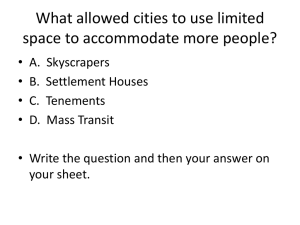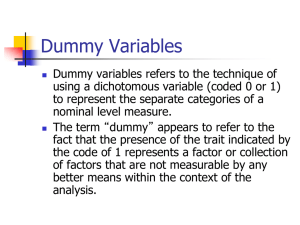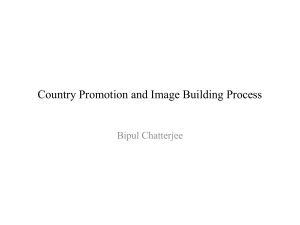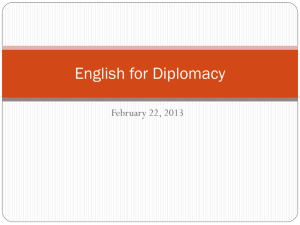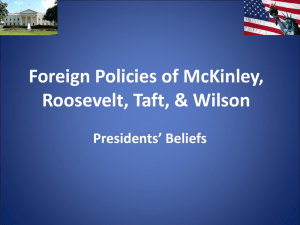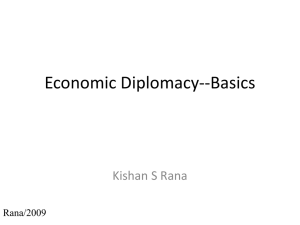Does economic diplomacy work?
advertisement
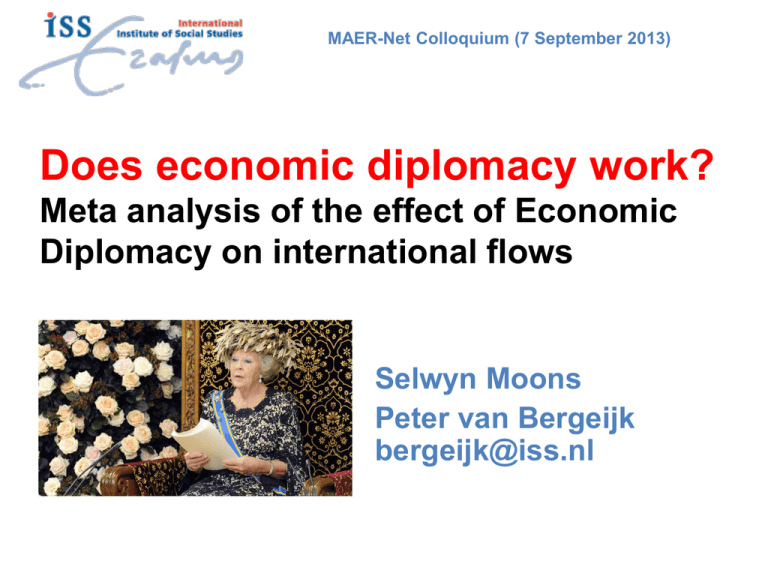
MAER-Net Colloquium (7 September 2013) Does economic diplomacy work? Meta analysis of the effect of Economic Diplomacy on international flows Selwyn Moons Peter van Bergeijk bergeijk@iss.nl The paper in a nutshell • Topic: the impact of diplomatic activity on trade & FDI • Two literatures: – 1980s&1990s international relations – 2000s international economics • 643 t-values taken from 29 studies • Evidence predominantly on exports and embassies • Question 1: Does it work? • Question 2: Sensitivity to model specification. 4/8/2015 Bergeijk 2 Today’s plan 1. 2. 3. 4. 5. Definition & motivation Literature Sample & bibliometrix Meta regression Conclusions Economic diplomacy Economic diplomacy is the use of government relations and government influence to stimulate international trade and FDI and is directed to: • • • • open markets and the opening of markets to stimulate cross border economic activities (imports, exports, FDI); the use of bilateral relationships to assist domestic companies which encounter difficulties abroad; improving the functioning of international markets in; increasing economic security by the promotion of (and compliance with) international rules and agreements Definition & motivation 4/8/2015 Bergeijk 4 Methuen 1703 Treaty Definition & motivation Classical Economists are Critical about Economic Diplomacy We have lost the French market for our woolen manufactures, and transferred the commerce of wine to Spain and Portugal, where we buy worse liquor at a higher price David Hume 1742 So far this treaty, therefore, is evidently advantageous to Portugal, and disadvantageous to Great Britain. Adam Smith 1776 Definition & motivation 4/8/2015 Bergeijk 6 Trends in modern economic diplomacy High level trade missions Export promotion agencies 250 200 150 100 50 0 1950-59 1960-69 1970-79 1980-89 1990-99 2000-03 Frankrijk Duitsland 1915 1920 1925 1930 1935 1940 1945 1950 1955 1960 1965 1970 1975 1980 1985 1990 1995 2000 2005 40 35 30 25 20 15 10 5 0 Verenigde Staten Definition & motivation 4/8/2015 Bergeijk 7 While transport costs decreased, distance did not die Definition & motivation 4/8/2015 Source: van Bergeijk and Brakman 2010 Bergeijk 8 Relevance of economic diplomacy • Cultural factors may make it necessary for national governments to get involved in international transactions. This is especially the case now that former communist countries account for an increasing share of world trade. • State enterprises may be the counterpart of a company operating in the international markets. This creates the necessity for entrepreneurs to seek cooperation with its national government to equalize the power balance and to improve its playing field. • (Political) uncertainty about international transactions must often be removed or reduced. Government involvement may signal that a transaction will not raise political resistance. • The information needed for international transactions sometimes requires involvement of government officials. Definition & motivation Literature(s) • Growing body of literature. • First wave: 1980s international relations – ‘general’ – mainly use political event data, dummies • Second wave: 2000s international economics – ‘specific’ – More refined analysis, main focus on embassy network and activities, cross section analysis • Binding element: most papers use the gravity equation • What changed: new datasets (instruments, period and countries) more computing power Literature Construction of the Sample Starting point: traditional review of literature Search strategy Sample & bibliometrix 4/8/2015 Bergeijk 11 Selection rules • Paper taken in to account when: – empirically address the question what the impact is of economic diplomacy on trade and investment flows – t - values are reported or can be (re)constructed – (Note: 1334 coefficients in 30 primary studies versus 643 t values in 29 studies) • Paper not taken into account: – logit or probit models (probability of trade) – incompleteness of key statistics (Note: 27 studies and 416 t values) Sample & bibliometrix 1334 regressions from 30 studies By instrument By international flow 3.6% 0.2% 8% 7% 33% 8% 23.6% 44% 72.6% Embassies Other offices EPA/IPA State visits Export Other visits Import FDI inflow FDI outflow Sample & bibliometrix 4/8/2015 Bergeijk 13 What do we know? Evidence by instrument Evidence by flow Diplomatiek klimaat Diplomatic climate Export Embassies Ambassades EPA/IPA EPA/IPA Import State visitsStaatsbezoek Andere posten Non embassies FDI Other trade Andere missies missions 0% Negatief (t<-2) 20% 40% insignificant 60% 80% 100% Positief (t>2) 0% 20% Negative (t<-2) 40% 60% Insignificant 80% 100% Positive (t>2) Sample & bibliometrix 4/8/2015 Bergeijk 14 4/8/2015 Polachek et al (2007) Nigh (1985) Bergeijk (1994) Bergeijk (1992) Gil-Pareja et al (2007) Pollins (1989a) Yakop and van Bergeijk (2011) Rose (2007) Volpe Martincus et al (2010) Gil et al (2007) Lederman et al (2007) Afman and Maurel (2010) Pollins (1989b) Summary (1989) Nitsch (2007) Morisset (2003) Volpe Martincus and Carballo (2010) Segura-Cayuela et al (2007) Yakop et al (2011) van Veenstra et al (2011) Biglaiser (2007) Head and Ries (2006) (Dis)agreement : t-values for economic diplomacy as reported in the primary studies 40 30 20 min max 10 median avg 0 -10 significant & negative mean/median insignificant mean/median reports negative t-values significant&postive mean/median; no negatives Sample & bibliometrix Bergeijk 15 State visits Number of t values considered 80 70 median t (each study) 60 50 all observations 40 all excluding outliers 30 weighted 20 10 weigthed excluding outliers 0 0 10 20 30 Aggregate t value 40 Sample & bibliometrix 4/8/2015 Bergeijk 16 Funnel plot 15 10 5 0 Funnel plot with pseudo 95% confidence limits -20 -10 0 10 20 30 t-statistic Sample & bibliometrix 4/8/2015 Bergeijk 17 Meta-regression analysis Categories of moderator variables Moderator var name Discription Empirical design factors FIXED EFFECTS Dummy, 1 if fixed effects estimate; 0 otherwise NOTOLS Dummy, 1 if other than OLS estimate; 0 if OLS COUNTRYSPECIFIC Dummy, 1 if primary sample is country specific; 0 otherwise PANEL Dummy, 1 if panel data; 0 if cross-section data PRE2000 Dummy, 1 if primary study is published before 2000; 0 otherwise Observations Number of observations in the dataset of primary study EXPORT Dummy, 1 if exports is dependant variable primary study; 0 otherwise IMPORT Dummy, 1 if imports is dependant variable primary study; 0 otherwise FDI Dummy, 1 if foreign direct investment is dependant variable primary study; 0 otherwise TOTALTRADE Dummy, 1 if total trade is dependant variable primary study; 0 otherwise EMBASSIES Dummy, 1 if embassies is included in primary study regressor; 0 otherwise Dependant variable Instrument of diplomacy CONSULATES Dummy, 1 if consulates is included in primary study regressor; 0 otherwise Dummy, 1 if embassies and consulates is included as 1 group in primary study regressor; 0 EMBASSIESANDCONSULATES otherwise FOREIGN EPA EIPA DIPLOMATIC RELATION STATEVISITS TRADEMISSION Metaregression analysis TRADE MISSIONS TOTAL Dummy, 1 if foreign export promotion office is included in primary study regressor; 0 otherwise Dummy, 1 if export/investment promotion agency is included in primary study regressor; 0 otherwise Dummy, 1 if diplomatic relation is included in primary study regressor; 0 otherwise Dummy, 1 if visits by head of state is included in primary study regressor; 0 otherwise Dummy, 1 if visits by minister of other representative is included in primary study regressor; 0 otherwise Dummy, 1 if state visits dummy is 1 or trade mission dummy is 1; 0 otherwise Estimated equations Probability of significant t (Logit, RE Logit, significance levels) P(yij=1)=α0+β1OBSERVATIONSij+β2NOTOLSij+β3COUNTRYSPECIFICj+β4GRAVI TYEQUATIONj+β5PRE2000j+β6,…,9 [primary dependent variableij]+β10,…,16 [instruments of diplomacyij]+εij (3) reference case is a primary study that measures the impact of foreign representation (embassies and consulates) on exports Metaregression analysis Findings I (Empirical design & dependent variable) Logit 5% OBSERVATIONS NOTOLS COUNTRYSPEC. GRAVITY. PRE2000 TOTALTRADE IMPORT FDI 0.64*** (2.8) -0.30 (-1.1) 0.63 (1.5) 1.98*** (2.9) -1.2* (-1.7) -0.75** (-2.3) -0.19 (-0.3) Logit 5% 0.29 (1.2) 0.27 (0.8) -0.80* (-1.70) 0.36 (0.60) 2.60*** (3.3) -1.18 (-1.5) -0.53 (-1.6) -0.26 (-0.4) 1% 0.58*** (2.67) -0.64** (-2.53) 1.20*** (3.03) 1.50** (2.3) -2.19*** (-3.1) -1.15*** (-3.4) -0.44 (-0.6) 1% 0.540** (2.05) 0.514 (1.49) -0.683 (-1.52) 1.52*** (2.57) 2.04*** (2.7) -2.50*** (-3.1) -1.03*** (-2.9) -0.19 (-0.3) Random Effects Logit 1% 1% 0.711** (1.97) 0.672*** 0.423 (2.58) (1.07) -0.865*** -0.688 (-2.61) (-1.14) 1.85** 1.46* (2.22) (1.90) 1.38 2.25** (1.3) (2.3) -2.81** -2.59** (-2.3) (-2.6) -0.85** -0.94** (-2.3) (-2.5) 0.13 0.0 (0.1) (0.0) Metaregression analysis 4/8/2015 Bergeijk 20 Findings II (Instruments of diplomacy) Logit EMBASSIES CONSULATES FOREIGN EPA OFFICE TRADE MISSION STATE VISIT EIPA DIPLOMATIC RELATION Logit Random Effects Logit 1% 1% 1.89* -0.12 (2.3) (-0.1) -0.9 -3.1*** (-1.6) (-4.1) 5% 0.43 (0.8) -1.8*** (-5.0) 5% -0.94 (-1.3) -3.4*** (-6.1) 1% 0.92* (1.7) -1.7*** (-4.8) 1% -0.52 (-0.8) -3.4*** (-6.3) -0.80*** -1.38*** -0.58** -1.6*** -1.11* -1.6*** (-2.7) -1.8*** (-3.3) -1.6*** (-4.2) -0.72* (-1.9) (-3.1) -2.5*** (-3.5) -2.2*** (-4.2) -1.5* (-1.92) (-2.0) -1.3** (-2.3) -1.5*** (-4.1) -0.53 (-1.47) (-3.6) -3.1*** (-4.0) -2.7*** (-4.9) -1.0 (-1.32) (-1.9) -0.7 (-0.8) -0.3 (-0.4) 0.0 (0.1) (-2.6) -2.3** (-2.4) -2.0** (-2.2) -0.86 (-0.9) 0.07 -0.91 0.67 -0.45 1.35 -0.11 (0.1) (-1.0) (1.0) (-0.5) (1.3) (-0.1) Metaregression analysis 4/8/2015 Bergeijk 21 Conclusions & issues for discussion • Evidence suggests “it works” but predominantly for exports and foreign network • Future research design: Lumping embassies consulates EPAs etc together creates potential downward bias of the effect • Sample selection rules; incomplete studies, inclusion N
